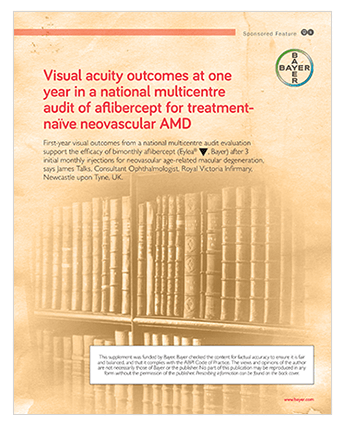
Therapeutic strategies using intravitreal anti-vascular endothelial growth factor (anti-VEGF) therapy have advanced the standard of care for neovascular agerelated macular degeneration (nAMD), preventing moderate visual acuity (VA) loss in most patients with nAMD. However, for optimal treatment outcomes, continuous or frequent injections and/or regular monitoring are required.
The greatest vision outcomes observed in clinical trials evaluating antiangiogenic agents ranibizumab and unlicensed bevacizumab for nAMD have been obtained with a 4-weekly dosing regimen (1–3). In the VIEW 1 and VIEW 2 (VEGF Trap-Eye: Investigation of Efficacy and Safety in Wet AMD) studies, two similarly designed, phase 3 randomised controlled clinical trials, aflibercept dosed either monthly or given bimonthly after 3 monthly loading injections was non-inferior to monthly ranibizumab in maintaining vision (losing <15 Early Treatment Diabetic Retinopathy Study [ETDRS] letters), and provided significant VA gains (≥15 letters vs. baseline VA) comparable to monthly ranibizumab at 52 weeks (4).*
Clinical trial treatment regimens for nAMD present challenges in real-world practice
Improvements in mean visual acuity observed in randomised clinical trials of anti-VEGF therapy for nAMD have not always been consistently replicated in everyday clinical practice (5–10). Patient heterogeneity, measurement techniques, the quality of service delivery, treatment regimens, and adherence with recommended protocols differ substantially in clinical settings within and across national health systems. Delays in the initiation of treatment, as well as recurrence of neovascular activity and/or progressive morphological changes, may lead to visual acuity loss (10,11). Discontinuous or variable follow-up in routine clinical care may also underlie observations of reduced efficacy of anti-VEGF therapy compared with clinical trial results (5–10). Service capacity and resource constraints pose challenges adopting and following the treatment regimens associated with optimal vision gains for patients with nAMD, with a continuous retreatment and monitoring burden impacting healthcare providers, patients, and national health systems. Various proactive and reactive anti-VEGF treatment regimens for nAMD have been progressively adopted in retinal practice in an effort to decrease injection and monitoring frequency. These include fixed-interval, pro re nata (PRN, treatment as needed), treat to target, and treat-and-extend protocols, as well as combination approaches.Download the pdf here
This supplement was funded by Bayer. Bayer checked the content for factual accuracy to ensure it is fair and balanced, and that it complies with the ABPI Code of Practice. The views and opinions of the author are not necessarily those of Bayer or the publisher. No part of this publication may be reproduced in any form without the permission of the publisher. Prescribing information can be found on the back cover of the PDF download.
